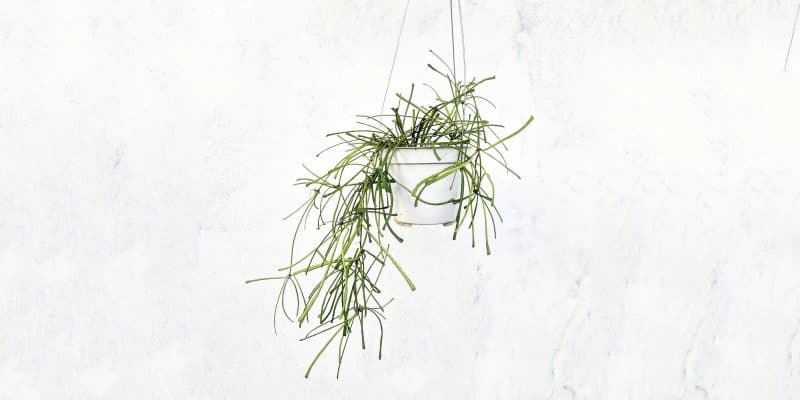Meet Hoya retusa, a plant that can add a touch of green to your home without demanding too much of your attention.
Hoya retusa is an eye-catching plant with long, wispy leaves that grow in a delightfully haphazard fashion. We’ll tell you everything you need to know about Hoya retusa care. After all, we could all use a little more green in our lives, right?
Table of Contents
Hoya Retusa Plant Care Guide
History, Habitat, and Characteristics
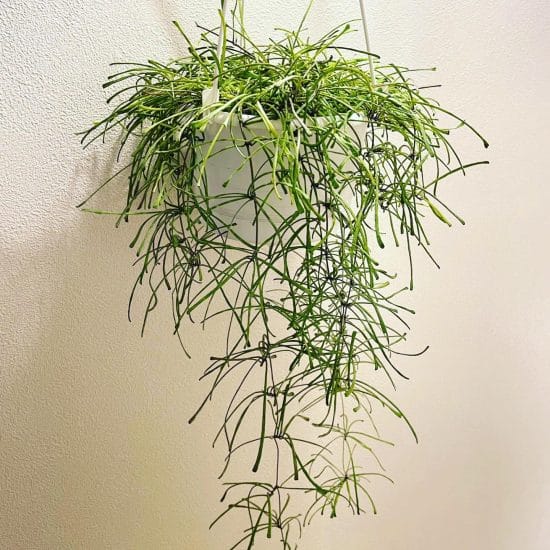
Hoya retusa is a vining epiphyte hailing from Western India and the eastern Himalayas. This plant prefers cooler temperatures compared to other hoya plants, which favor warmer climates. In its native habitat, Hoya retusa grows in the dappled shade of the forest canopy, making it an excellent choice for indoor spaces with indirect light.
With its narrow, notched leaves, Hoya retusa stands out from the crowd. These unique leaves resemble pine needles or grass blades with rounded edges, and they hide an interesting secret: their veins are completely invisible to the naked eye. Plus, each leaf has a small bump at the end, making it look like a tiny green toe.
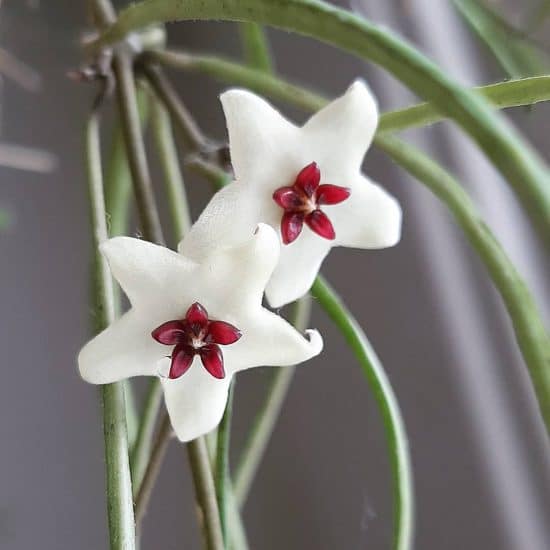
Hoya retusa’s flowers appear singly or in small groups of just two or three, unlike other hoyas which produce clusters with more flowers. Shaped like stars, the flowers of Hoya retusa boast a white corolla and a red or dark burgundy corona. Their scent is distinctive, featuring notes of orange blossom or lemon and a grassy-lemony undertone.
(Makes sense for this grass-leafed hoya.)
Fun fact: Did you know that Hoya retusa owes its unique leaf structure to its forest home? As an epiphyte, it mostly lives on the surface of other plants rather than rooting into the ground where it can soak up its own water. Its slim and succulent leaves help the plant survive drought and make it relatively low maintenance as a houseplant!
Light
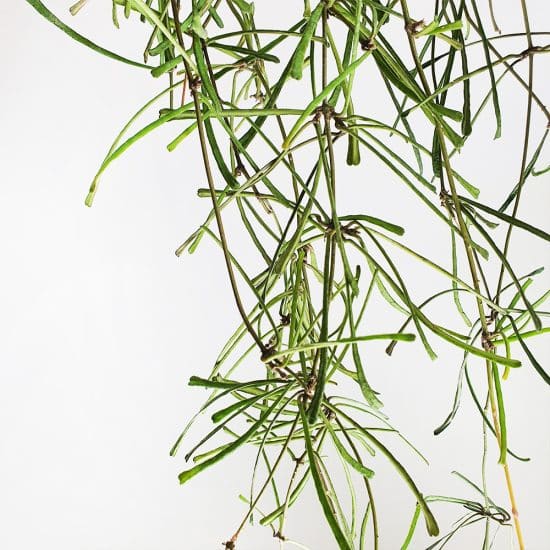
Being adapted to lower light conditions, Hoya retusa plants thrive in morning and afternoon sunlight. They don’t like the harsh mid-day sun, so be sure to protect them from the scorching, direct rays during peak hours.
If you do place your plant near a south-facing window, you’ll want to locate it a few feet away, add a sheer curtain, or hide it behind some other sun-loving plants, as Hoya retusa prefers bright, indirect light.
Signs of not enough light include slow or leggy growth, small or pale leaves, and a lack of flowering. To boost the light, move the plant closer to a window or consider adding a grow light to help it thrive.
You’ll also want to watch out for too much of a good thing: scorched, yellowing or brown leaves, or wilted foliage might suggest your Hoya retusa plant is getting too much sun. To shield your Hoya retusa, move it to a spot with less direct light.
Water
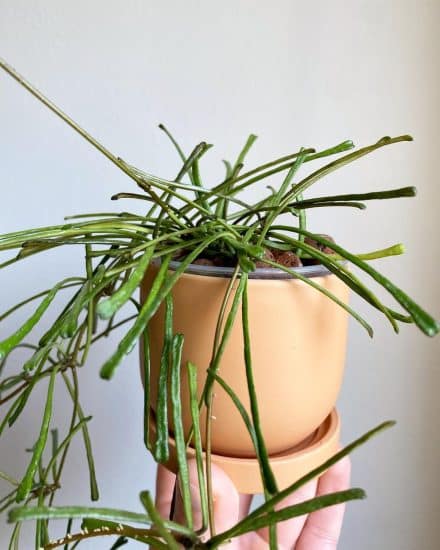
Water your Hoya retusa plant about once a week. Be sure to check the soil’s moisture level beforehand, though; it should be watered when the top 1-2 inches of soil is dry. Give the soil a thorough soak each time you water it with room temperature water.
Wilting or yellowing leaves, as well as leaves that appear to be curling up, may be signs of not enough water. In such cases, you may need to increase your watering frequency to keep your tropical plant hydrated and happy.
On the other hand, too much water can be harmful as well. Common indicators of overwatering include mushy or discolored leaves and consistently damp soil. If your Hoya retusa displays these symptoms, reduce your watering frequency and let the soil dry out more between sessions.
Temperature and Humidity
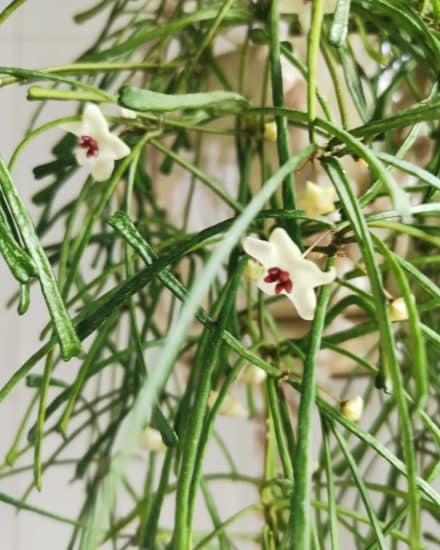
Hoya retusa prefers cooler temperatures with a noticeable difference between day and night. Strive for daytime temperatures around 65-80°F (18-27°C) and at night, let them dip to around 50°F (10°C). This fluctuation can encourage flower production. Keep in mind that temperatures below 50°F (10°C) may harm the hoya plant, so shield it from drafts and chilly windows.
Hoya retusa thrives in humidity between 40-70%, which is crucial for the buds and flowers to open. Raise humidity by regularly misting your Hoya retusa, placing it on a pebble tray, or by using a humidifier.
Watch out for signs of too little humidity, like wilting leaves or brown leaf tips. Conversely, mold or yellowing leaves could indicate excessive humidity.
Soil and Planting
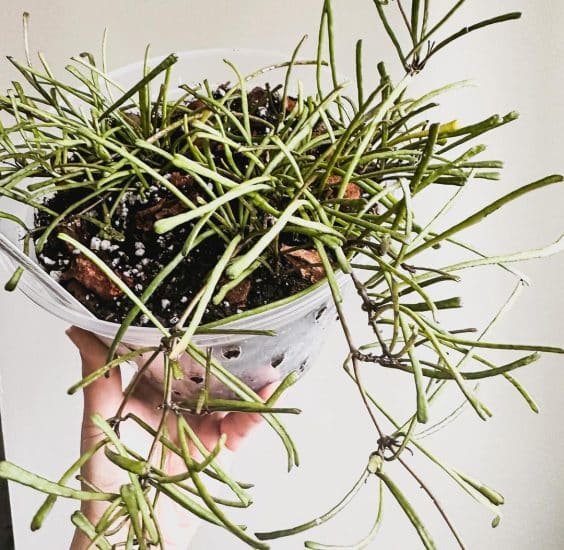
Hoya retusa prefers a well-draining, chunky potting mix consisting of orchid bark, soil, charcoal, and perlite. However, you can also use a grower’s mix or an epiphytic mix (like an orchid mix), with added perlite for better drainage. The key is to make sure the mix is light, airy, and doesn’t retain too much moisture.
To achieve the right balance, add some coco peat to the mix. This not only helps lock in the irght amount of moisture, but also protects the plant from overwatering and root rot (a common issue with Hoya retusa).
It’s all about creating that happy medium!
When planting or repotting your Hoya retusa, consider using a terracotta pot and make sure your new pot has drainage holes. Terracotta pots are great for these plants because they let excess moisture escape, preventing overwatering (and keeping your tropical plant happy).
This flowering plant also looks great in a hanging basket. Just make sure to properly support it, especially because they can get a bit heavy with moist soil.
Fertilizer
Treat your Hoya retusa to a well-balanced, half-strength synthetic or organic fertilizer. It doesn’t need to be fertilized often — just once every three to four weeks during the growing season should do.
Keep an eye out for signs of over-fertilizing, though, such as yellowing leaves or slowed growth. If you spot any of these, just flush the soil with water to get rid of excess nutrients and scale back on fertilizer applications in the future.
Propagation
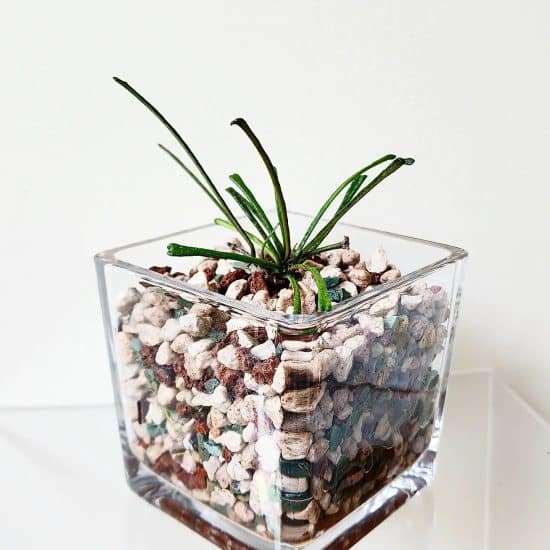
We’ll cover propagating Hoya retusa using stem cuttings, which is a super simple method. You can choose to root them in soil, water, or sphagnum moss.
Propagating Hoya retusa via stem cuttings:
- Snip a healthy stem cutting: Wait until the plant finishes blooming, and then locate a stem with at least two nodes and well-developed aerial roots. Remember to use clean and sterilized scissors or a sharp knife when cutting between the nodes.
- Pick a method. a) Try soil propagation: Prepare a pot filled with well-draining soil. Carefully place your stem cutting with its aerial roots on the soil surface, making sure the nodes are touching the soil. Use U-shaped wires to keep the cutting in place and maintain slightly moist conditions without overwatering.
b) Give water propagation a go: Grab a suitable container and remove any lower leaves from the stem to prevent decay. Fill it with clean water and put the stem cutting in, ensuring the aerial roots are submerged. Change the water every 2-3 days and don’t forget to provide bright, indirect light.
c) Experiment with sphagnum moss: Place the stem cutting with its aerial roots in a clean container and surround it with a cushion of sphagnum moss. Make sure to keep the moss moist and maintain a humid atmosphere for optimal growth. - Set up the perfect environment: No matter which method you choose, a humid environment will encourage healthy rooting. A mini greenhouse or propagation box can be your best friend here, providing the ideal conditions for your cutting to thrive. If you don’t have either, you can easily make one by putting a plastic bag over your cutting or using a cut soda bottle.
- Watch your cutting grow: Keep an eye on your cutting as it develops new roots and leaves. Once you notice a strong root system, it’s time to transplant it into a pot with well-draining soil.
Common Issues
Hoya retusa is known for its resilience, but even this hardy houseplant can encounter a few common issues. By recognizing these problems and understanding how to address them, you’ll be well-equipped to help your Hoya retusa thrive.
Not Blooming
Under ideal conditions, Hoya retusa can bloom multiple times a year. If you notice that it isn’t producing any flowers, this might be due to a lack of sufficient light or humidity.
To encourage blooming, make sure your plant is near a window with bright, indirect sunlight. Boost the humidity by placing it on a tray filled with water and pebbles, using a humidifier, or frequently misting it by hand.
Along with proper light and humidity, adequate fertilization is essential for healthy blooming. Feed your Hoya retusa a balanced liquid fertilizer every three to four weeks during the growing season to provide the nutrients it needs.
Keep in mind that patience is crucial — it might take some time before your plant starts producing those lovely flowers!
Slow Growth
If you notice that your Hoya retusa isn’t growing very quickly, it could be because of insufficient light, low-quality soil, or improper watering.
First, ensure that your plant is receiving enough bright, indirect sunlight. Next, check the soil quality. It’s vital to use a well-draining, nutrient-rich potting mix that will support your plant’s development.
Be sure that you’re watering your Hoya retusa thoroughly and waiting until the top 1-2 inches of soil feel dry before watering again. Finally, don’t forget to provide your plant with the nutrients it needs by fertilizing every three to four weeks during the growing season with a balanced liquid fertilizer.
Yellowing Leaves
Yellowing leaves on a Hoya retusa can be a sign of a few potential issues. Overwatering is a common cause, as it can lead to root rot and oxygen deprivation in the roots. Really make sure your potting soil is given a chance to dry out slightly between waterings.
Another cause of yellowing leaves is excessive light exposure. Hoya retusa prefers bright, indirect light, so make sure it isn’t exposed to harsh, direct sunlight.
Pests and Diseases
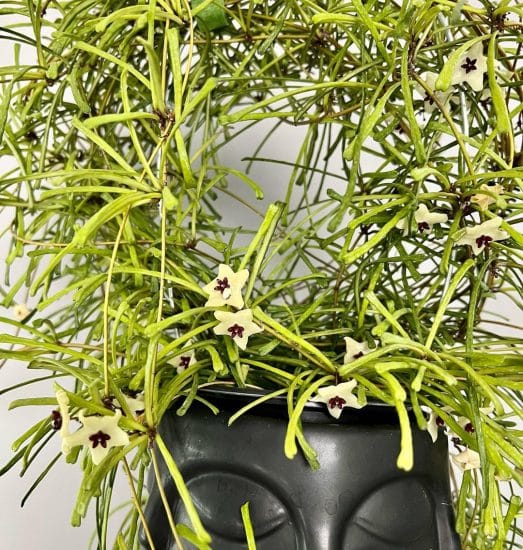
Hoya retusa is a tough little houseplant, but even the strongest tropical plants can encounter a pest or two along the way.
Pests
Your Hoya retusa may be less prone than other houseplants to pest pressures, but that doesn’t mean mealybugs, aphids, and thrips won’t try their luck. Give the leaves and stems a once-over on a regular basis to check for any uninvited guests.
If mealybugs come to stay, you’ll notice cotton ball-like bits on the underside of leaves and along the stems. To send them packing, gently pick them off or use a water spray to wash them away. Then, apply a mix of dish soap and water or neem oil to both sides of the leaves to banish them for good.
As for aphids and thrips, these minuscule marauders can wreak havoc by sipping sap from your precious plant. Keep an eye out for wilting leaves or sticky residue, which could signal their presence. To kick them to the curb, reach for insecticidal soap or neem oil, and give your Hoya retusa a good rinse to wash away any lingering intruders.
Root Rot
Overwatering or poor drainage can lead to soggy soil, which could spell disaster in the form of root rot.
The key to thwarting root rot lies in using well-draining soil and a pot with drainage holes. Make sure to let the soil dry out between waterings to steer clear of waterlogged situations.
If you suspect root rot has reared its ugly head, gently remove your Hoya retusa from its pot and take a close look at the roots. If you spot any slimy, mushy, or blackened roots, trim them away with sterilized scissors or a sharp knife. Then, repot your hoya in fresh, well-draining soil.
Conclusion
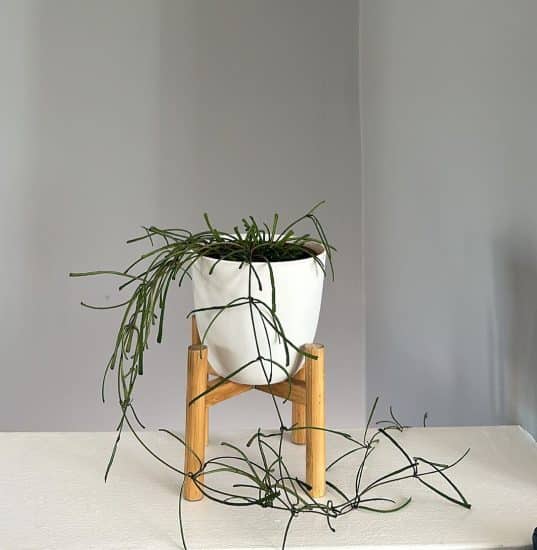
That’s a wrap for our Hoya retusa care guide!
With its unique foliage and show-stopping flowers, Hoya retusa is a lovely addition to any indoor garden. What’s more, since it’s low-maintenance, Hoya retusa is perfect for novices who are just getting started with one of their first indoor plants.
Hoya retusa care summary:
- Thrives in bright, indirect sunlight, but is also well-adapted to lower light conditions.
- Water thoroughly once a week, ensuring the soil is neither too dry nor damp.
- Maintain cooler temps (65-80°F /18-27°C) during the day, with a drop to around 50°F (10°C) at night.
- Aim for higher humidity levels (40-70%), which is crucial for bud and flower development.
- Use a well-draining, chunky potting mix, and provide balanced, half-strength fertilizer.
- Propagate through stem cuttings using soil, water, or sphagnum moss methods.
We hope you’ve got all the confidence and knowledge to care for your Hoya retusa. If you found this guide helpful, feel free to share it with friends and fellow plant lovers. And as always, if you have any questions, don’t hesitate to reach out.
Take care, and happy planting!
FAQ
What does Hoya retusa smell like?
Though the scent varies from plant to plant, Hoya retusa flowers generally smell sweet and subtle, making them a pleasant addition to your space. The fragrance is often more noticeable during the evening, when the flowers release their aroma to attract pollinators.
What is the difference between Hoya linearis and Retusa?
Hoya linearis and Hoya retusa are both members of the Hoya genus, and we’re not surprised you might confuse them. Hoya retusa features flat, grass-like foliage that juts out from the stem.
Though both plants share a love for cooler temperatures and higher humidity levels, Hoya linearis typically requires more moisture in the potting medium than Hoya retusa. Additionally, their flowers differ slightly in appearance: Hoya linearis blooms are usually white with creamy centers, while Hoya retusa flowers feature a purple-ish red corona.
Does Hoya retusa flower?
Yes, Hoya retusa does produce flowers! These plants are known for their striking white blooms that cluster together to form a beautiful, star-shaped arrangement. The flowers usually have a reddish corona in the center, adding a touch of color to the otherwise white petals.
Flowering typically occurs during the warmer months, but maintaining the right temperature (65-80°F during the day) and humidity levels will encourage your Hoya retusa to flower.

